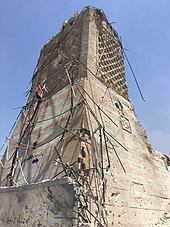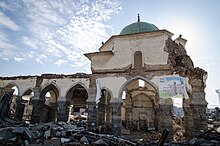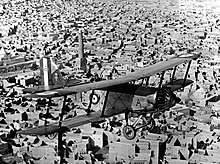Great Mosque of an-Nuri
The Great Mosque of an-Nuri ( Arabic جامع النوري, DMG Ǧāmiʿ an-Nūrī , an-Nuri-Mosque '), named after the Zengid governor Nureddin Zengi , was a mosque from the 1170s in the west of the Iraqi city of Mosul .
The mosque has been depicted on the back of the 10,000 dinars banknote since 2003 . It was largely destroyed on June 21, 2017.
history
The building was built in 1172/1173. A prayer niche and some columns have been preserved from this original structure. The height of the single minaret was about 45 meters. However, it was inclined, as was reported as early as the 14th century. That's why it wasالحدباء / al-Ḥadbāʾ / called 'the hunchback'. In local popular belief, the minaret bowed to the Prophet on the ascension of Muhammad . In contrast, scientists cite solar radiation, which affects plaster of paris and brick , as the cause of the curvature.
The foundations were damaged during the First Gulf War with Iran , and in 2012 the United Nations issued a warning of the minaret's collapse.
In the mosque, the leader of the terrorist organization " Islamic State " (IS), Abu Bakr al-Baghdadi , gave a Friday sermon ( Chutba ) in his only public appearance on July 4, 2014 , after he was told on June 29, 2014 by the IS spokesman, Abu Mohammad al-Adnani , had been declared " Caliph ".
destruction
In the course of the battle for Mosul , the mosque was largely destroyed on June 21, 2017. While the Iraqi armed forces and a spokesman for the International Alliance against the Islamic State spoke of a demolition by IS, the latter alleged through its agency Amaq that the building had been hit in a US air strike, which was in turn denied by the US-led military coalition : The US Air Force had not carried out any attacks in the area at the time. The Iraqi army spoke of a "historic crime". Iraqi President Haider al-Abadi interpreted the destruction as an “official admission” by IS that it had lost the battle for Mosul. The commander of the Mosul operation said the jihadists had destroyed "one of the greatest treasures of Mosul and Iraq". ISIS militias tried to destroy the minaret as early as 2014, but the population was able to prevent this with a human chain. The foundation stone for the reconstruction of the mosque was laid in mid-December 2018 .
See also
Web links
- An-Nuri mosque on ArchNet (English)
Individual evidence
- ↑ Fear of Mosul's crooked minaret. In: The Standard . April 6, 2017. Retrieved May 28, 2017.
- ↑ Hannah Strange: Islamic State leader Abu Bakr al-Baghdadi addresses Muslims in Mosul . In: Telegraph . 5th July 2014.
- ^ Sylvia Westall: After Iraq gains, Qaeda offshoot claims Islamic "caliphate" . In: Reuters . June 29, 2014 (English).
- ↑ Video of the demolition of the minaret; Source: Iraq. Army, via CNN
- ↑ IS is said to have blown up Al-Nuri mosque in Mosul . In: fr.de . June 22, 2017. Retrieved June 24, 2017.
- ^ Mosque blown up: the birthplace of IS is in ruins. In: WAZ . June 22, 2017. Retrieved June 22, 2017.
- ↑ Chistoph Ehrhardt: With the anger of desperation . In: FAZ.net . June 22, 2017. Retrieved June 24, 2017.
- ↑ IS destroyed mosque with oblique minaret in Mosul , In: Welt.de . June 22, 2017. Retrieved June 26, 2017
- ^ Mosque in Mosul that was destroyed by IS is being rebuilt. Spiegel Online, December 16, 2018, accessed on the same day.
Coordinates: 36 ° 20 ′ 35.5 ″ N , 43 ° 7 ′ 36.7 ″ E




